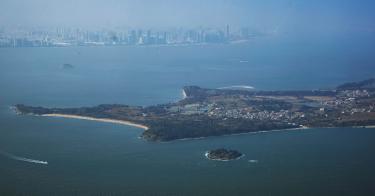Last May, as a new Taiwanese president took office, the U.S. Navy increased its presence in the South China Sea, operating two aircraft carrier strike groups in the area for the first time in more than a decade.
Beijing, though not happy about the deployment, offered only a muted response. It had its hands full with COVID recovery, escalating tensions with India, and growing international condemnation of its suppression of the Uyghur population.
The heightened U.S. naval presence not only dampened Chinese intimidation toward Taiwan, it had salubrious effects elsewhere…for a while. For example, Chinese ships had been harassing a survey ship, the West Capella, chartered by the Malaysian government for an oil exploration job in its own economic exclusive waters, but that behavior diminished once U.S. ships entered the scene.
Now, Beijing’s back at it. In just the past few weeks, the People’s Liberation Army, air force and navy have conducted major maneuvers around Taiwan, practicing wartime operations and exhausting Taiwanese defense forces.
>>> EVENT: Lessons from the West Capella Incident: Successful Naval Presence in the South China Sea
Earlier, in mid-March, more than 200 Chinese fishing vessels, Chinese Coast Guard and maritime militia massed in Philippine waters in what could be a pretext for a season of harassment. And once again, U.S. and British naval forces are headed to the region.
At a recent hearing before subcommittees of the House Armed Services and Foreign Affairs Committees, witnesses described a maritime Asia at a tipping point. It’s a complicated situation of overlapping maritime claims, domestic politics, and economics. The question is: What role should the United States play to deter Chinese aggression and lower the chances of conflict?
A window into the future is Japan’s response to Chinese maritime encroachment. Unlike the dynamic state of affairs in the South China Sea, Japanese and Chinese maritime forces have maintained a tense balance in the East China Sea.
Since 2012, China has maintained a brisk tempo of air and water incursions around the Senkaku islands—a group of uninhabited islands administered by Japan and protected by U.S. defense treaty obligations. Still, China doggedly claims the islands as its own.
Beijing’s aggression has fueled a shift in Tokyo’s diplomatic and military posture. Japan is repositioning more and more of its Self Defense Forces and Coast Guard toward the Senkakus and has consistently increased its defense spending to keep pace with the rising risk. It has also revised U.S.-Japan defense guidelines to enable a more proactive security partnership with the U.S.
What the Senkaku islands and West Capella experiences make clear is that naval presence does matter. In both cases, a sustained presence led to a wave of positive regional diplomatic and partner military actions.
However, forward presence doesn’t come cheap. Greater investment in our naval forces and operations will be necessary for the U.S. to counter such metastasizing risks and alter Beijing’s (and Moscow’s) strategic calculations.
And, yes, Moscow figures into the maritime Asia equation. In July 2019 and again last December, China and Russia flew bombers together in the Sea of Japan. The two are set to renew a strategic partnership this July—something that will only add complexity to an increasingly stressing global maritime competition for the Navy.
Some argue that the U.S. cannot, and should not, try to counter China’s coercive maritime actions. This would be a mistake. It ignores Beijing’s long record of encroachment throughout the South China Sea, which was greatly expanded and sustained by its ‘island’ building in disputed locations. Beijing’s interest here is longstanding, and its approach has been largely effective since 1994 when it erected structures on the Philippines’ Mischief Reef.
China’s intentions are not likely to change. If the U.S. and its allies do nothing to complicate or slow Beijing’s grey zone strategy, they risk ceding the global commons of maritime Asia. Inaction would also encourage China to push harder misjudging U.S. commitments, thereby increasing the risk of conflict.
A successful strategy must include diplomatic efforts to attract and bolster like-minded partner nations such as India, Vietnam, Indonesia, the Philippines, and Malaysia. But soft power alone will not dissuade Beijing, nor will it attract the partners we need. So what else can be done?
First, presence for purpose: The U.S. and allied naval presence must be prioritized and resourced more vigorously to decisive theaters such as the South China Sea, and our deployed ships must be given new tools for grey-zone operations.
>>> Rebuilding America’s Military: The United States Navy
Second, build a new model Navy: The U.S. must grow and equip the fleet to meet the combined challenge of China and Russia. There is an urgent need to recapitalize U.S. shipyards and build the workforce needed to deliver and man the ships.
Third, deliver a compelling cost proposition: This will require rethinking the conduct of U.S. diplomacy, building partner capacity, and fueling economic development to convince our citizens, as well as our partners, that they can’t forego investing in maintaining a free and open Indo-Pacific.
All said, the dangers in maritime Asia are no longer a distant concern; they are here today, and very real. Both the outgoing and current Indo-Pacific commanders, Admirals Davidson and Aquilino, recently testified as much, commenting on the likelihood of China triggering a conflict in the next six years.
To deter the growing Chinese armada arrayed against us requires more than matching numbers in arsenals and fleets. We must grow our fleet while also rethinking naval operations in a wider diplomatic and economic context. We need a new naval statecraft: one that leverages and enables naval presence while demonstrating the economic benefits for a free and open Indo-Pacific.
This piece originally appeared in Defense One




